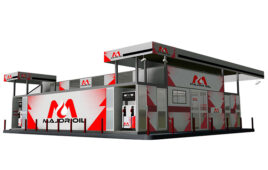 By Brian Milne, Energy Editor, Schneider Electric
By Brian Milne, Energy Editor, Schneider Electric
Seasonal factors are the primary driver in lifting the gasoline futures contract on the New York Mercantile Exchange more than 60% from a multiyear low registered in January, and are the wind in the sails for a continued move higher in March.
The forward curve, which shows the value of deferred delivered supply, moved into backwardation in beginning March, a bullish market structure implying strength in futures contracts with nearest delivery.
The gasoline futures contract, called Reformulated Blendstock for Oxygenate Blending (RBOB), is pushing those gains into the retail market, with the US average retail price for regular grade gasoline climbing each week in February after 17 consecutive weeks in which the average declined data from the Energy Information Administration shows. The national average is set to continue higher in March.
The primary wholesale market is at various stages of transitioning to summer gasoline grades, which have lower Reid Vapor Pressure specifications that make the fuel more costly to produce. The industry is also in the seasonal turnaround season, when refiners shut units for service which reduces gasoline output, although the current refinery maintenance period is not that heavy. Lastly, the market anticipates higher gasoline demand during the warmer months in spring and summer.
Amid these bullish features—higher production costs, lower output and greater demand—the NYMEX April RBOB futures contract ushered in March by gapping higher on the spot continuation chart—a continuous plot line for the futures contract with closest delivery, as it replaced the now expired March contract. The March contract expired at $1.7676 gallon on Feb. 27 while the April contract settled at $1.9779 gallon, already near a test of psychological resistance at $2 gallon.
The April contract settled 75cts or 61% higher on Feb. 27 than the $1.2265 gallon low plumbed Jan. 13, a six-year low on the spot continuation chart. EIA’s U.S. retail gasoline average has gained 28.8cts or 14.1% from Jan. 26 when it posted a nearly six-year low at $2.044 gallon to Feb. 23. Clearly, retail gasoline prices have a lot more upside in the coming weeks, especially if the futures market continues its pre-season rally.
Yet, in climbing more than 60% from a January low, has the futures market got ahead of itself?
During the past five years, RBOB futures have rallied an average 42% from a fourth quarter low to an early year high reached in the first or second quarter, with the pre-season rally peaking in March during two of the past three seasons. Moreover, the pre-season rally high during this five-year period was also the annual high for each of these years except in 2014, when geopolitical events spiked the contract in June.
In 2014, nearest delivered RBOB futures rallied 61.83cts or 24.8% from a $2.4945 gallon low registered November 2013 to a $3.1128 gallon high in April 2014, with the contract later reaching a calendar year high for 2014 in late June at $3.1520 gallon. In 2013, the pre-season advance was 71.5cts or 28% and $1.0012 or 41% for the 2012 rally, with the peak for both those years established in March.
Disappointing consumption figures cut short the pre-season rallies over the past few years, partly because the gains made in futures were pushed to retail and the higher pump prices discouraged demand. During the first several weeks of 2015 through Feb. 20, the EIA indicates gasoline supplied to the primary market, also known as implied demand, is up a sharp 458,000 bpd or 5.5% at 8.744 million bpd compared with the corresponding year-ago period.
The higher implied consumption rate so far this year is spurred by lower retail gasoline prices that, while up nearly 30cts from the current low in late January, are still down more than $1 gallon from year ago.
Moreover, the better-than 60% move by nearest delivered RBOB futures from the January low reflects a less than 40% retracement of the selloff from the June 2014 high of $3.1520 gallon to January’s low, with the 50% retracement point at $2.1892 gallon. Could we see another 20cts increase in nearest delivered RBOB futures in the coming weeks?
Part of the impetus for the RBOB rally was a spate of unplanned downtime at refineries serving the Los Angeles, Chicago and Philadelphia markets in February, some of which was resolved as the calendar flipped to March. Yet, gasoline supply is hovering near a 25-year high at 240 million bbl.
Building gasoline supply in early 2015 came with higher processing rates than usual, with gasoline output averaging 9.1065 million bpd so far this year compared with a five-year average of 8.804 million bpd and year ago at 8.769 million bpd per data from the EIA. This higher processing rate is likely to continue as refiners draw on bulging storage tanks of crude supply that have swelled to more than 430 million bbl on Feb. 20, 20% more than in 2014, and the highest domestic crude supply rate in more than 80 years.
Currently, crack spread trading favors gasoline, in which an RBOB futures contract is bought while a crude oil contract is sold. This supports higher gasoline values.
An overarching consideration is whether or not the NYMEX West Texas Intermediate crude futures contract bottomed in late January at $43.58 bbl. Nearest delivered WTI futures have consolidated, trading on either side of $50 bbl that have led some to speculate the low is in. However, with domestic supply at the highest point since the early 1930s and US crude production at the highest rate since the early 1970s and still continuing to grow, others expect another down leg for the WTI contract that would pressure RBOB futures.




